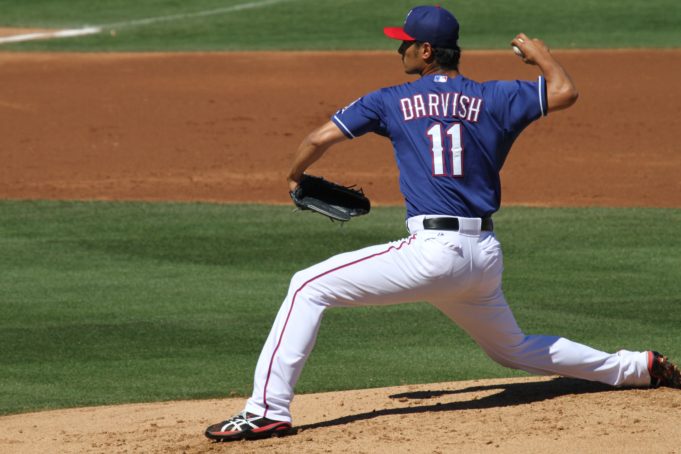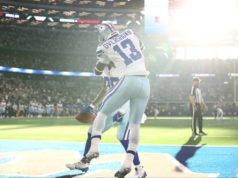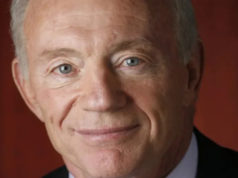A baseball trading deadline revolves around seeing the future. A team acquiring proven talent attempts to peer three months hence and occasionally as much as 15 months. A franchise adding prospects needs to see further, sometimes as much as four years or more.
Ironically, a word we use when talking about a baseball club’s ability to try to predict its near future is “window.” A winning club’s collection of talent is said to have a period of time when it’s a viable title contender before those players age and leave due to free agency, retirement, or cost-benefit analysis.
Heading into this season, the Texas Rangers returned the core of consecutive division title-winning teams led by the 2015 American League Manager of the Year. They added fan favorite and power threat Mike Napoli, plus TCU product Andrew Cashner. They had reason to expect continued progress from young players like Rougned Odor, Nomar Mazara, and Joey Gallo.
Their window of opportunity seemed open. The 2017 Rangers have shown promising bursts, including May’s 10-game win streak and another five-gamer in June against first-place teams Washington and Houston. Overall, however, they have won fewer games than they have lost. Young players have not taken necessary steps forward, though the 23-year-old Gallo’s OPS north of .830 shows progress. Veterans have mostly underperformed. Cole Hamels missed time with an oblique strain. The relief pitching has inexplicably beached itself, as bullpens sometimes do.
This season’s window of contention, then, has likely rattled closed for the Rangers, and their trade deadline activity reflected it. July 31 represents a key date in the baseball calendar, because it is the last date teams can trade players without sending them through waivers. From now through the end of the season, a team wishing to trade a player must put him through revocable waivers, a process that allows any team to claim him. This stymies a lot of August trades. Teams, therefore, generally decide by July 31 whether their windows to win include the current campaign.
This July, the Rangers traded three established players for younger ones unlikely to help them win games this season. Catcher Jonathan Lucroy went to the Rockies for a player to be named later; relief pitcher Jeremy Jeffress moved to Milwaukee for minor league right-hander Tayler Scott; and starting pitcher Yu Darvish headed west to the Los Angeles Dodgers for prospects Willie Calhoun, A.J. Alexy, and Brendon Davis.
The returns for Lucroy and Jeffress will not have a substantial impact on any Rangers window. With the former posting a career-low batting average and the latter’s ERA at a career-high 5.31 at the time of the trade, the Rangers had to sell low. Baseball-reference.com rated both at below replacement level in 2017, implying that any average player would have performed better. One could argue that moving them might have made sense no matter where you found yourself in the standings, especially given that Colorado now has to pay a portion of Lucroy’s $5-plus million salary.
Darvish, however, likely offers substantial present value to any team. Baseball Reference estimated his WAR at 2.8, higher than any other Ranger. He has struck out more than a batter per inning and offers a bewildering selection of pitches. Banister declared that losing his team’s only All-Star selection doesn’t mean his group won’t have a chance to contend. He should say that, because his job entails motivating the men he manages, and players view the possibility of October baseball as an important enticement. Also, Banister could be right. We don’t know because we haven’t played the games yet. Other contenders could suffer slumps or injuries, and his roster could improve its performance. Darvish’s departure makes it unlikely, however, that the Rangers’ window of contention will extend into 2017.
The Rangers fan must ask that if 2017 is not the team’s window, when is? The team’s current run dates to 2010, with Texas playing beyond the standard 162 regular season games every year since then other than an injury-crushed 2014. Its success rested on a strong minor league system fortified by prescient trades, draft choices, and international signings. The club supplemented its internal promotions with free agent signings and by using its farm depth to trade for the likes of Hamels, Cliff Lee, and Mike Adams.
If General Manager Jon Daniels polishes the glass on his crystal ball and spies a chance to contend next season, it means he sees enough tools either currently on the roster, ready to be promoted from the minor leagues, or likely to be acquired in the offseason. Perhaps internal evaluations indicate they can expect improved performance from current guys. They might also look at signing free agents. Darvish will become available again, if they want to make a run at him. Last year, the Yankees effectively rented Aroldis Chapman to the Cubs before re-signing him in the offseason. The Cubbies did the same the year before in bringing Jason Hammel back from Oakland after dealing him there mid-season.
Darvish makes $11 million this year and can expect to command more than double that next year, barring injury. Texas has $61.5 million in combined commitments to three thirtysomething players next year (Hamels, Adrián Beltré, and Shin-soo Choo) and the 29-year-old Elvis Andrus. Could they afford to re-up with Darvish and, since they would need to improve on what they had this season even with the big right-hander, also add another big-ticket free agent like Wade Davis or J.D. Martinez?
In a sport without a hard salary cap, the Rangers’ revenues have an impact on payroll acquisitions. The way ticket sales cycles go, the club will likely have less money to work with for next year’s budget. A non-playoff season means less money coming in during the all-important winter season and group ticket sales period. We can also expect limited sponsor revenue-producing additions to the current ballpark (à la the Hyundai Club or left field video board of recent years) with a new stadium on the horizon.
In terms of internal help, it’s not out of the question that Calhoun or Ronald Guzman could emerge from AAA to impact the big club next year. Perhaps Nick Martinez will surface as a reliable starter. The Rangers’ farm system is not what it once was, though, weakened in part by the trades for Ryan Dempster, Matt Garza, and others, made to extend the current competitive window. This year’s trade deadline deals won’t hurt, but they won’t move the needle there, either.
If the Rangers’ next window isn’t 2018, when is it? To get back to winning its division consistently, and earning its best chance at succeeding in the crapshoot that is the postseason, Texas must overcome its A.L. West foes. Most of the teams have remained bunched in the middle of the standings this year. Various services rank the minor league systems of the Rangers, Angels, and Mariners in the lower third of baseball. The A’s get placed a bit higher, and their own deadline trade of Sonny Gray improved their system further, but unless they get a new facility and improve their ability to boost payroll, Oakland isn’t a long-term threat.
The young and talented Astros present problems, however. In addition to running away with the division in 2017, they possess one of the major leagues’ top development pipelines. How can the Rangers match up with them in 2019 and beyond? In 2008 and 2009, Daniels and his staff, along with then-president Nolan Ryan, brilliantly identified who in their current organization could help them win and which players they’d need to acquire. They thought they might surprise in 2009 (and they almost did), and they knew they would in 2010. That’s their challenge now — to figure out when they’ll be good again and who needs to still be here when it happens. It’s not an easy process, because everyone wants to win now, but the organization needs, above all, to be realistic about it.
Daniels’ office, like many on the fourth floor of Globe Life Park in Arlington’s center field building, has a window overlooking the diamond. Every so often, workers walk the ballpark balconies cleaning the glass. Rangers fans hope they do a good job, because for JD and his staff, it’s all about clear vision and windows.












